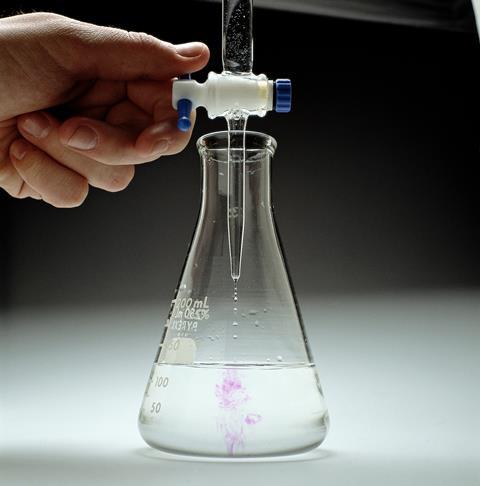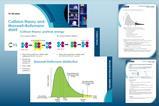Contexts, ideas and activities for discussing pH, indicators, logs – and more

Acids and bases are everywhere: in household products, food, our bodies. This topic provides an opportunity to learn about the world around us, including issues surrounding the environment, medicine and agriculture that may reel students in.
What students need to know
- Students should understand there are several different theories of acids and bases (ie, the Arrhenius, Brønsted–Lowry and Lewis theories).
- Strong acids/bases are fully dissociated in aqueous solutions, while weak acids/bases are only partially dissociated. Ka is the acid dissociation constant. Acids and bases form conjugate acid–base pairs.
- The pH scale is a logarithmic scale used as a measure of H+ concentration. pH curves show how pH changes during an acid–base titration and can be used to determine the equivalence point.
- Kw is the ionic product of water and can be used to calculate [H+], [OH-] and pH of a solution.
- Indicators are weak acids that change colour when they donate H+ ions. Buffers are solutions that minimise changes in pH when small amounts of acid/alkali are added and play an important role in biological (eg blood) and non-biological (eg shampoo) systems.
Threshold concept
The concept of equilibria is key to understanding acids and bases at this level. A good understanding of equilibria will allow students to explain the behaviour of weak acids and bases and understand pH calculations. It also explains the equivalence point on some titration curves and how indicators and buffers work.
Misconceptions
Some common difficulties and misconceptions your students may have include:
- Understanding the difference between the terms strong, weak, concentrated, dilute.
- All salts when dissolved in water have a pH of 7: this is only true for those made from a strong acid and base. (For example, copper sulfate is an acidic salt with pH 4.6 and sodium ethanoate is a basic salt with a pH around 9.0.)
- The pH scale is logarithmic: pH = -log10 [H+]. Understanding the maths is a common difficulty and explains why it is possible to have pH of -1.
- Understanding the relationship between pKa and Ka: pKa = -log10 Ka. The use of logs actually makes it easier to see acid strength; the lower the value for pKa, the stronger the acid, as the equilibrium lies more to the left. Similar issues occur with the ionic product of water: pKw = -log10 Kw.
Learn more in chapter 8 of the Beyond appearances report and the EiC article Acids and bases: creating solutions.
Misconceptions
Some common difficulties and misconceptions your students may have include:
- Understanding the difference between the terms strong, weak, concentrated, dilute.
- All salts when dissolved in water have a pH of 7: this is only true for those made from a strong acid and base. (For example, copper sulfate is an acidic salt with pH 4.6 and sodium ethanoate is a basic salt with a pH around 9.0.)
- The pH scale is logarithmic: pH = -log10 [H+]. Understanding the maths is a common difficulty and explains why it is possible to have pH of -1.
- Understanding the relationship between pKa and Ka: pKa = -log10 Ka. The use of logs actually makes it easier to see acid strength; the lower the value for pKa, the stronger the acid, as the equilibrium lies more to the left. Similar issues occur with the ionic product of water: pKw = -log10 Kw.
Learn more in chapter 8 of the Beyond appearances report (LINK) and the EiC article ‘Acids and bases: creating solutions’ (LINK).
Ideas for your teaching
Indicators and titrations
Indicators are weak acids in which the dissociated form (HIn) has one colour and its conjugate base (In-) has a different colour or is colourless. Rainbow fizz is a memorable experiment, often used in lower school chemistry as an introduction to the topic, and provides an opportunity to revisit prior learning as well as a starting point for discussing how indicators work. The Rainbow fizz revisited resources provide all you need to get started and lead on to choosing the right indicator for a titration. The titration screen experiment provides practice with pH curves, equivalence points and indicator selection in context-based problems, including aspirin tablets and hair products.

Acid and base strength
Compare a strong and weak acid by carrying out a series of quick experiments. For example, measure the pH and conductivity of 1M HCl and 1 M CH3CO2H, then observe how they each react with magnesium ribbon or marble chips. Comparing the results will help students to understand the differences, especially if you ask them to interpret the reactions of the acids in terms of the number of H+ ions present.
You could then go on to explore the equilibria involving carbon dioxide in an aqueous solution, which provides an opportunity to revisit the concept of equilibria before moving on to introduce the acid dissociation constant Ka, which is a mathematical relationship that indicates the degree of dissociation. In this reaction there are several possible equilibria, which makes it quite complicated but allows for interesting discussions and practice writing expressions for Ka. Follow up the theory by determining Ka for a weak acid or base using pH measurements.
Indicators and titrations
Indicators are weak acids in which the dissociated form (HIn) has one colour and its conjugate base (In-) has a different colour or is colourless. Rainbow fizz is a memorable experiment, often used in lower school chemistry as an introduction to the topic, and provides an opportunity to revisit prior learning as well as a starting point for discussing how indicators work. The Rainbow fizz revisited resources (LINK) provide all you need to get started and lead on to choosing the right indicator for a titration.The titration screen experiment (LINK) provides practice with pH curves, equivalence points and indicator selection in context-based problems, including aspirin tablets and hair products.
Acid and base strength
Compare a strong and weak acid by carrying out a series of quick experiments. For example, measure the pH and conductivity of 1M HCl and 1 M CH3CO2H, then observe how they each react with magnesium ribbon or marble chips. Comparing the results will help students to understand the differences, especially if you ask them to interpret the reactions of the acids in terms of the number of H+ ions present.
You could then go on to explore the equilibria involving carbon dioxide in an aqueous solution with a demo (LINK), which provides an opportunity to revisit the concept of equilibria before moving on to introduce the acid dissociation constant Ka, which is a mathematical relationship that indicates the degree of dissociation. In this reaction there are several possible equilibria, which makes it quite complicated but allows for interesting discussions and practice writing expressions for Ka. Follow up the theory by determining Ka for a weak acid or base using pH measurements (LINK).
The submicroscopic
Modelling the behaviours of acid and alkaline solutions helps students to appreciate what is going on at the molecular level. The PhET simulations pH Scale and Acid–base solutions allow students to investigate a range of different substances, relating the strength of an acid or base to the extent to which it dissociates in water. Students can visually compare the molecules and ions present in a strong acid with a weak acid using the dissociation equation HA + H2O ⇋ A- + H3O+ (and similarly for bases). The ability to switch the pH scale between a logarithmic and linear scale highlights numerically why a logarithmic scale is used to measure pH.
Real-life contexts
Relating the chemistry to real-life contexts adds extra interest for students. Examples include:
- Household products such as cleaning products and food (citrus fruits, tomato-based products and processed grain are acidic, while nuts, legumes and vegetables are alkaline).
- Neutralisation has a role to play within agriculture as many cultivated plants require a neutral soil to grow in, but soil pH varies from 3–10.
- The environment – this topic links to air pollution, acid rain and ocean acidification, which many students are passionate about.
- Medicine, for example to diagnose and treat conditions such as heartburn, indigestion or respiratory alkalosis – a condition in which the pH of blood (around 7.4) is above normal, often caused by hyperventilation.
- The three main buffer systems in the body (carbonic acid bicarbonate, phosphate and protein buffer systems), require pH to be controlled so that various biochemical processes can take place, and are especially relevant for those students also studying biology.
The submicroscopic
Modelling the behaviours of acid and alkaline solutions helps students to appreciate what is going on at the molecular level. The PhET simulations pH Scale (LINK) and Acid–base solutions (LINK) allow students to investigate a range of different substances, relating the strength of an acid or base to the extent to which it dissociates in water. Students can visually compare the molecules and ions present in a strong acid with a weak acid using the dissociation equation HA + H2O ⇋ A- + H3O+ (and similarly for bases). The ability to switch the pH scale between a logarithmic and linear scale highlights numerically why a logarithmic scale is used to measure pH.
Real-life contexts
Relating the chemistry to real-life contexts adds extra interest for students. Examples include household cleaning products (try the Chemistry in your cupboard resources: LINK), agriculture (try this resource on soil pH: LINK), medicine (try this resource linking pH to drug absorption: LINK), ocean acidifcation – and so much more.
Assessment
Diagnostic probes such as Acid strength can be used to assess your students’ understanding at various points in the topic.
Concept maps are useful tools to assess whether students can make connections between key ideas. The Revising acids activity provides a framework and starting point which can be easily extended to include post-16 concepts by including terms such as equilibria, equilibrium constant, ionic product, log. Students should then be encouraged to find a link between these concepts and add them in the concept map.
The Acids and bases and Inorganics in aqueous solution Starter for ten resources provide a series of short quizzes and activities that can be used as either retrieval practice at the start of a lesson or as an assessment activity. Topics include pH and Kw, Brønsted–Lowry and Lewis bases, acid–base titrations and buffer solutions.
Diagnostic probes such as Acid strength (LINK) can be used to assess your students’ understanding at various points in the topic.
Concept maps are useful tools to assess whether students can make connections between key ideas. The Revising acids activity (LINK) provides a framework and starting point which can be easily extended to include post-16 concepts by including terms such as equilibria, equilibrium constant, ionic product, log. Students should then be encouraged to find a link between these concepts and add them in the concept map.
The Acids and bases (LINK) and Inorganics in aqueous solution (LINK) Starter for ten resources provide a series of short quizzes and activities that can be used as either retrieval practice at the start of a lesson or as an assessment activity. Topics include pH and Kw, Brønsted–Lowry and Lewis bases, acid–base titrations and buffer solutions.
Take-home points
- Use diagnostic probes to promote discussion and find out what your students think.
- At the start of the topic, make sure your students have a good understanding of the basics of equilibria before going further.
- Use practical activities to promote thinking and to collect real data for use in calculations.
- Provide lots of opportunities to practise calculations. Make sure students know how to use their calculators.
- Simulations are great, but do evaluate before use in the classroom.
- Be careful with language. Incorrect use of the terms strong, weak, concentrated and dilute can lead to confusion.
- Remember, putting the chemistry into real-life contexts provides extra interest.














3 readers' comments